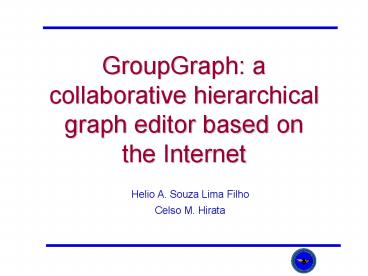GroupGraph: a collaborative hierarchical graph editor based on the Internet - PowerPoint PPT Presentation
1 / 25
Title:
GroupGraph: a collaborative hierarchical graph editor based on the Internet
Description:
Java and Java RMI. Characteristics: Object Oriented. Security. Portability. Java Platform: ... Chat. Telepointers. Communication between the client and server ... – PowerPoint PPT presentation
Number of Views:43
Avg rating:3.0/5.0
Title: GroupGraph: a collaborative hierarchical graph editor based on the Internet
1
GroupGraph a collaborative hierarchical graph
editor based on the Internet
- Helio A. Souza Lima Filho
- Celso M. Hirata
2
Requirements
- Development of a graph editor tool
- hierarchical graph
- allows the collaborative work
- based on the Internet
- portability
3
Outline
- Modeling, collaborative work, infrastructure
- Editor components
- Restriction model, lock, perception mechanisms,
communication model - Case Studies
- Final Comments
4
Modeling
- Model it is a simplified representation of the
system being studied, it includes only the
relevant aspects regarding the goal of the study. - Techniques that use graphs
- Activity Cycle Diagrams (ACD)
- Petri nets
- Automata
5
Infrastructure Internet
- Various hosts that share neither memory nor clock
- Each computer owns its own memory and operating
system - Communication by message-passing
- Issues resource sharing, scalability,
reliability, availability, performance, and
security.
6
Java and Java RMI
- Characteristics
- Object Oriented
- Security
- Portability
- Java Platform JVM e API.
7
Distributed Shared Data
- There are two basic mechanisms replication and
migration. - Issues are transparency, ease of programming,
scalability and performance. - We use the concept of total replication and no
migration.
8
Groupware
- CSCW (Computer Supported Cooperative Work)
studies and tries to understand how people work
together (both with and without groupware), and
how the computer and related technologies can be
designed to support effective collaborations. - One of the goals of these studies is to construct
computer systems to allow cooperative work. - Real time groupware allows two or more
geographically separated people to work together
at the same time through a computerized
environment.
9
Editor Components
- Server keeps the a copy of the graph controls
the synchronization among clients. - Client owns a copy of the graph interacts with
the user. - Model of Restrictions define as the properties
for graph editing.
10
Model of restriction
- Allows to configure the graph editor.
- Node selection.
- Properties of the nodes.
- Properties of the edges.
11
Global Properties
- Allows the visualization of the restriction model.
12
Properties
- Exhibit the properties of the node or edge.
13
Lock mechanism
- To lock it is necessary to select first.
- Node and edge can be selected
- In the current implementation, the lock is for
the composite node
14
Perception Mechanisms
- Chat
Telepointers
15
Communication between the client and server
16
Case Study 1 Petri net representation of the
dinning philosophers
17
The Petri net representation the restriction
model
18
The dinning philosophers editing
19
Case Study 2 Interconnection network of switches
20
Interconnection network ACD representation of
the switch
21
Interconnection network model
22
Interconnection network sub-model
23
Final Comments and Conclusions
- Some limitations of the tool
- Locking mechanism
- Number of users
- Security
- Fault tolerance
24
Related Work
- GroupSim software for collaborative discrete
event simulation based on the WWW. - GroupPlaces architecture for groupware based on
the WWW. - Graph editors
- Graph Editing Framework (GEF).
- aiSee software for graph visualization.
25
Future Work
- Integrate with a DBMS
- Integrate with other tools such as software
generation and analyzers - Support to other types of specifications such as
UML - More elaborated tools for cooperative work































